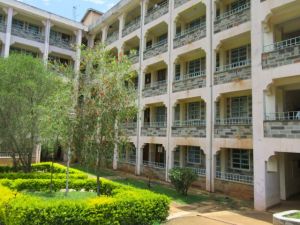This morning I dropped off my completed Kenyan work permit application at the Registrar’s (Admin) Office. I have learned that I need to add the “Admin” because there is more than one Registrar’s Office. Last Friday he said he would complete his part of the application and, I believe I heard him right, hand carry the application to Nairobi. Included in the application were 2 passport photos, my Curriculum Vitae, and my official University of California, Berkeley transcript documenting my Doctor of Optometry and Doctor of Philosophy degrees. Apparently, they have backed off of the requirement that I show them my original diplomas. I attribute that change of heart to the face-to-face meeting I had with the administrator.
Most administrators, professors, and lecturers do not have computers on their desks. Definitely, administrative assistants and receptionists do not have computers on their desks. That would be a huge investment. Things are done the old fashioned way using paper and carbon paper, when necessary. Almost everyone has a mobile phone, but texting is uncommon. To communicate and make decisions, a telephone call or face-to-face meeting usually does the trick.
I thought I’d do a photo tour of the Optometry and Vision Science Department, along with other photos of the Masinde Muliro University of Science and Technology. I snapped a few on the way back from lunch. If you want to see the photo a little larger, you can click on it.
The Optometry and Vision Science Department is on the ground floor in the middle. You might be able to make out the rectangular sign. There is a reception desk, the Head of Department’s office, and a slightly larger room with 4 large desks, or should I say, way too large of desks. It’s hard to walk between them.
The small clinic is about 40 yards away. It was completed only two months ago and only serves University staff, professors, faculty, and students. I am not sure what the student population size is at the moment, but we have the potential to see perhaps 5 to 10 patients a day once we get up and running at full speed, maybe more. Right now the clinic volume has been 0 to 5 patients a day, although the receptionist showed me a stack of at least 10 patients waiting for examinations. We have all been busy completing the 4th year student qualifying examinations and grading the last couple of days. This afternoon I was writing a lecture in the clinic conference room and two patients stopped by so I gave them an eye exam.
Jennifer is the clinic receptionist, on the left. Pamela (center) and Patricia stopped by to say hi and chat.
There is a frame selection room, but no frames. I am not sure of the reasons why, perhaps the funds ran out. But we still do not have frames or a way to place lenses into the frames. But I am choosing to look on the bright side. We have a clinic we did not have three months ago, with good quality instruments. The rest will be worked out in time.
I believe there are nine clinic rooms, although not all are equipped with the optometry lane as we call it with chair, stand, projector, phoropter, and slit lamp.
Looking down the clinic hallway.
Just outside the clinic there is this beautiful Nandi Flame tree (Spathodea campanulata).
The Nandi Flame tree has orange-red flowers. It is native to the area and grows well. Apparently, it grows so well that it has been listed as one of the world’s top 100 invader species. That reminds me of the fact that in Arizona the mesquite tree is native to Southern Arizona and is a beautiful, hardy tree. In Hawaii, the mesquite tree is an invasive species that is spreading out of control, crowding out the native Hawaiian dry land trees.
This building, right next to the clinic, was just completed last week. It has many classrooms and lecture halls.
Many of the administrative offices are in small tin-roofed shacks. When it starts to rain in the afternoon it can be hard to hear what the person next to you is saying.
There is a lot of open land on the campus. Here students are walking across a field to and from class.
This tree is on the driveway in and out of campus. It has a sign posted that there are bees nesting above and not to disturb them.
This was the scene this afternoon around 1pm just outside the campus main gate. The two lane highway is the main thoroughfare through town. About 50 km (31 miles) to the south lies Kisumu, and 110 km to the north is Kitale, gateway to the Mt. Elgon National Park. Another interesting town not too far away is Eldoret, gateway to the Kerio Valley National Park. Over time I will explore these places, which are the lesser known Kenyan National Parks. Nakuru, to the southeast about 4 hours by car, is well known for a lake with pink flamingos. A bit farther, perhaps 6 hours to the south, lies the famous Maasai Mara National Park, partly in Kenya but mostly in Tanzania.
In an earlier post I mentioned by bewilderment that there were not more bicycles shops given that there are bikes everywhere. Well, I was mistaken. There are bicycle shops all over the place, they just don’t have walls or a roof. 
The guys at the bike shop helped me pump up my tires. The bike came with a pump but to tell you the truth I can’t figure out how it works. I will buy a small bike pump in the US when I am there in a couple weeks, and bring it back. That’s it for today. I am waiting to find out the details of my optometry teaching tour which might start as early as this Wednesday. I’ll let you know when I know.













